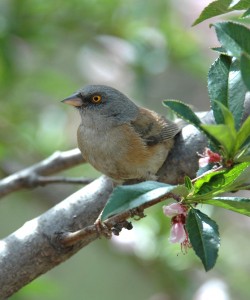The Next Junco

Over the entrance to that “intellectual space” in which researchers debate taxonomic limits in the genus Junco, there stands a gate bearing an inscription in fourteenth-century Tuscan:
LASCIATE OGNI SPERANZA VOI CH’INTRATE
Just as Virgil guided Dante through the Inferno, I wish that I could offer you safe passage through the many circles of biological complexity centered on the single hellish question of how many junco species there really are. But there’s no such thing as safe passage. There’s no getting around it: the juncos are devilishly complicated.
Most birders in North America focus on telling the different junco forms apart by sight, which is appropriate, since most North American juncos sing a single high-pitched musical trill that is pretty much the same whether it comes from a Slate-colored, a Pink-sided, an Oregon, or a Gray-headed Junco:
A few of the Dark-eyed Juncos in all of these populations will occasionally sing a slightly more complicated two-parted trill:
And some of the Gray-headed Juncos in the southern Rocky Mountains will sometimes end with a slight flourish of 1-2 different notes:
As one moves farther south in the mountains, the junco songs become gradually more complicated. The “Red-backed” Juncos of northern Arizona sing significantly slower and more frequently two-parted songs than the Gray-headed Juncos they closely resemble:
By the time you reach southern Arizona, the juncos’ eyes have turned yellow, virtually all of their songs have become 2- or 3-parted, the trills have slowed, and terminal flourishes have become common:
Farther south, in central Mexico, the songs get even more complex, with fewer repeated notes, but they don’t last quite as long:
The southward trend towards brevity and complexity continues all the way down to the isolated, fireproof Volcano Junco of Costa Rica and Panama:
“Baird’s” Junco, an outlier
At least one isolated Junco population doesn’t really fit the pattern we’ve just described. At the southern tip of Baja California, high up in the Laguna mountains, one finds birds named after Spencer Baird that closely resemble the Yellow-eyed Juncos of adjacent mainland Mexico, except slightly paler, with a light brown back and soft pinkish flanks. Oh, and they happen to sing an extremely complex song:
Anyone who has ventured into the Sierra La Laguna knows that the endemic Baird’s Junco, currently considered a subspecies of the Yellow-eyed Junco by the AOU, doesn’t sound a bit like most other members of its genus. When we first heard it on the WFO/SJV expedition in 2008, some in our group looked around for a Passerina bunting; I thought I might be hearing a Rufous-crowned Sparrow. Howell and Webb (1995) say the song suggests a small Troglodytes wren, and split the species from Yellow-eyed in large part on that basis.
I recorded enough Baird’s Junco song in Baja California in 2008 for a formal analysis, but I didn’t have the statistical skills to pull it off by myself, so I collaborated with Clint Francis, who was then a graduate student in Alex Cruz’s lab here at the University of Colorado in Boulder, to try to figure out whether Baird’s song was really as different from the songs of mainland juncos as it seemed to the human ear. We wanted to know whether the more complex junco songs from central and southern Mexico might show an intermediate syntax linking the very different-sounding Baja and Arizona populations.
Our results, published this month in the Wilson Journal of Ornithology (subscription required), show that Baird’s sings quite differently than mainland juncos. Figure 1 from our paper illustrates this quite nicely:

Baird’s Juncos virtually never repeat a note or phrase, and they use far more unique notes and phrases than either Oaxaca or Arizona birds. In these features, the values for Baird’s didn’t even overlap with the values for mainland birds. A discriminant function analysis of 12 features easily distinguished Baird’s from mainland birds, but did not easily distinguish between Oaxaca and Arizona songs.
What does this mean? On the whole, it means that human ears don’t lie: Baird’s Juncos really do sing a highly differentiated song. It is quite possible that this song would reproductively isolate them in the unlikely event that they came into contact with mainland populations, meaning that Baird’s Junco may deserve full species status. We stopped short of recommending a split in our paper until playback experiments and/or genetic analyses can be done. However, a few years from now, Baird’s Junco (Junco bairdi) might just take its place on the AOU checklist as the next new North American Junco species.